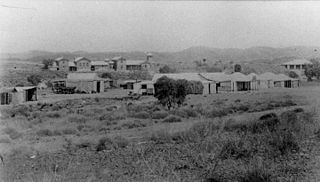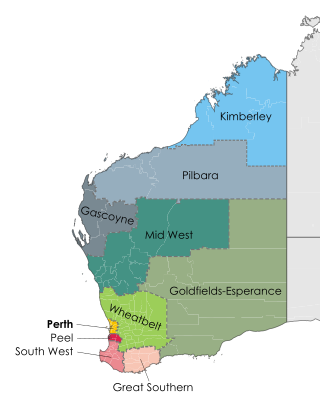Related Research Articles
The Pilbara is a large, dry, thinly populated region in the north of Western Australia. It is known for its Aboriginal peoples; its ancient landscapes; the red earth; and its vast mineral deposits, in particular iron ore. It is also a global biodiversity hotspot for subterranean fauna.

Marble Bar is a town and rock formation in the Pilbara region of north-western Western Australia. It was the social centre of European settlers in the Pilbara region during the early 1900s, predating the construction of other towns now established.

Nullagine is an old goldrush town in Western Australia's Pilbara region. It is located on the Nullagine River 296 km south-east of Port Hedland and 1,364 km north-north-east of Perth on the old Great Northern Highway.

The electoral district of Pilbara is a Legislative Assembly electorate in the state of Western Australia. Pilbara is named for the region of Western Australia in which it is located. It is one of the oldest electorates in Western Australia, with its first member having been elected to the Second Parliament of the Legislative Assembly at the 1894 elections.

The Port Hedland–Marble Bar railway was a railway in the Pilbara region of Western Australia, running into the hinterland from the north-west coast.

Pilbara newspapers is a selection of newspapers published in the Pilbara region of Western Australia.
Peak Hill is the name of a goldfield, locality and the site of a gold mining ghost town in the Murchison Region of Western Australia. The gold mine covers 2,162 hectares and consists of four open-cut mines, titled: Main, Jubilee, Fiveways and Harmony.
De Grey Station is a pastoral lease, formerly a sheep station and now a cattle station, approximately 80 kilometres (50 mi) east of Port Hedland on the mouth of the De Grey River in the Pilbara region of Western Australia.
Main Roads Western Australia controls the major roads in the state's Pilbara region. There are two main highways in the region: Great Northern Highway, which travels north through the region to Port Hedland and then north-west along the coast, as well as North West Coastal Highway, which heads south-west from Port Hedland. A series of main roads connects towns to the highways, and local roads provide additional links. The majority of these roads service the western half of the region, with few located in the various deserts east of the Oakover River. Roads are often named after the towns or areas they connect.
Yarrie or Yarrie Station is a pastoral lease and cattle station that once operated as a sheep station, located approximately 73 kilometres (45 mi) north east of Marble Bar and 170 kilometres (106 mi) south east of Port Hedland in the Pilbara region of Western Australia. The De Grey River runs through the property.
Muccan or Muccan Station is a pastoral lease and cattle station that once operated as a sheep station, located approximately 68 kilometres (42 mi) north east of Marble Bar and 155 kilometres (96 mi) south east of Port Hedland in the Pilbara region of Western Australia. Kookenyia Creek and the De Grey River run through the property. The country is gently undulating with large areas of spinifex.
James Isdell was an Australian pastoralist and politician who was a member of the Legislative Assembly of Western Australia from 1903 to 1906, representing the seat of Pilbara.
Bonney Downs Station is a pastoral lease that was once a sheep station but now operates as a cattle station in Western Australia.
Carlindi Station is a pastoral lease that was once a sheep station but now operates as a cattle station in Western Australia.
Coongan Station is a pastoral lease that was once a sheep station but now operates as a cattle station in Western Australia.
Lalla Rookh Station, often referred to as Lalla Rookh, is a pastoral lease that once operated as a sheep station but now operates as a cattle station.
Mount Edgar Station, often referred to as Mount Edgar, is a pastoral lease that once operated as a sheep station but now operates as a cattle station.
Pippingarra Station is a pastoral lease that once operated as a sheep station and now operates as a cattle station, located 25 kilometres (16 mi) south east of Port Hedland and 125 kilometres (78 mi) north west of Marble Bar in the Pilbara region of Western Australia.
The Shire of Marble Bar was a local government area in the Pilbara region of Western Australia. It was established as the Bamboo Road District on 4 September 1896, and was based in the now-former town of Bamboo Creek. The first election was held in January 1897.
The Shire of Nullagine was a local government area in the Pilbara region of Western Australia.
References
- ↑ "OURSELVES". The Pilbarra Goldfield News. Vol. I, no. 1. Western Australia. 19 February 1897. p. 2. Retrieved 26 June 2017– via National Library of Australia.
- ↑ The Pilbarra goldfields news, Pilbarra Goldfields News, 1897, retrieved 2 October 2021 - the library microform entry notes: Published at Marble Bar 19 Feb. 1897-27 July 1912. "Printed and published by Ernest A. Williams (19 Feb. 1897-24 Sept. 1897),[and then by others (1 Oct. 1897-27 July 1912)] for the proprietors at their Printing Works, Francis-street, Marble Bar, in the colony of Western Australia" (vol. 1, no. 1 (19 Feb. 1897)); then at Port Hedland (6 Aug. 1912-20 Mar. 1923), "[Final issues] printed and published by the Proprietor, T.G. Heyden, Richardson Street, Port Hedland" (13 Aug. 1912)
- ↑ Western Australia. Department of Mines (1896), West Pilbarra G.F., Pilbarra G.F, Dept. of Mines, retrieved 2 October 2021
- ↑ Western Australia., Department of Mines; Western Australia. Parliament. Minutes and votes and proceedings of the Parliament ... with papers presented to both Houses (1904), Map of Pilbarra and West Pilbarra Goldfields Western Australia, Dept. of Mines, retrieved 2 October 2021
- ↑ "PILBARRA GOLDFIELD". The Inquirer and Commercial News . Vol. LII, no. 1570. Western Australia. 16 January 1891. p. 3. Retrieved 2 October 2021– via National Library of Australia.
- ↑ "PILBARRA GOLDFIELD". Western Argus . Vol. 40, no. 2246. Western Australia. 4 July 1933. p. 4. Retrieved 2 October 2021– via National Library of Australia.
- ↑ "THE PILBARRA GOLDFIELD NEWS". The Daily News . Western Australia. 18 September 1907. p. 5 (THIRD EDITION). Retrieved 10 January 2020– via Trove.
- ↑ "LOCAL AND GENERAL". Northern Times . Vol. XVII, no. 842. Western Australia. 1 April 1922. p. 2. Retrieved 2 October 2021– via National Library of Australia.
- ↑ "MINING NEWS". The Pilbarra Goldfield News. Western Australia. 6 July 1907. p. 2. Retrieved 10 January 2020– via Trove.
- ↑ The Pilbarra goldfields news, Ernest A. Williams, 1897, retrieved 10 January 2020